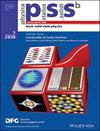四元 Cu2ZnSnS4 和 Cu2NiSnS4 纳米晶体的 "绿色 "水合成、结构和光学特性
IF 1.8
4区 物理与天体物理
Q3 PHYSICS, CONDENSED MATTER
引用次数: 0
摘要
Cu2ZnSnS4-like chalcogenides 中的元素取代为创造具有可调特性的替代性低成本光伏和热电材料提供了潜力。本研究首次报道了以硫代乙醇酸为稳定剂在水溶液中 "绿色 "合成阳离子取代的铜镍硒纳米晶体(CNTS NCs)。研究了 CNTS NCs 在胶体溶液和薄膜中的结构和光学特性,并将其与在类似条件下获得的 Cu-Zn-Sn-S (CZTS) NCs 进行了比较。这两种化合物的 NC 尺寸估计都在 1.5-2.5 nm 之间。这两种 NC 都表现出强烈的非配位组成和与阳离子无序凯氏体 Cu2ZnSnS4 相对应的结构,而这正是此类季铵盐基金属铬化物的共同特征。CNTS 和 CZTS NC 的声子拉曼光谱显示出非常相似的线形,但 CNTS 声子带的宽度更大、频率更低,这可能是由于阳离子无序性更强所致。这两种类型的 NC 的吸收都持续延伸到可见光范围,估计带隙为≈2.2 eV,而亚带隙吸收则是由于乌尔巴赫尾。CNTS 的吸收系数在 700 纳米波长处为 α > 102 cm-1,在 400 纳米波长处为 α > 104 cm-1。本文章由计算机程序翻译,如有差异,请以英文原文为准。
“Green” Aqueous Synthesis, Structural, and Optical Properties of Quaternary Cu2ZnSnS4 and Cu2NiSnS4 Nanocrystals
Element substitution in Cu2 ZnSnS4 ‐like chalcogenides offers the potential to create alternative low‐cost photovoltaic and thermoelectric materials with tunable properties. In this work, the “green” synthesis of colloidal cation‐substituted Cu–Ni–Sn–S nanocrystals (CNTS NCs) in aqueous solutions using thioglycolic acid as a stabilizer is reported for the first time. The structural and optical properties of CNTS NCs are studied in colloidal solutions and thin films, and are compared with those of Cu–Zn–Sn–S (CZTS) NCs obtained under similar conditions. The NC sizes of both compounds are estimated to be in the range of 1.5–2.5 nm. Both NCs exhibit strongly non‐stoichiometric composition and a structure corresponding to cationically disordered kesterite Cu2 ZnSnS4 , which are common features of such quaternary metal‐based chalcogenides. The phonon Raman spectra of CNTS and CZTS NCs exhibit very similar lineshapes, but the CNTS phonon band has a larger width and lower frequency, presumably due to stronger cation disorder. The absorption of both types of NCs extends continuously through the visible range with an estimated bandgap of ≈2.2 eV and sub‐bandgap absorption due to an Urbach tail. The absorption coefficient of CNTS is determined to be α > 102 cm−1 at 700 nm and α > 104 cm−1 at 400 nm.
求助全文
通过发布文献求助,成功后即可免费获取论文全文。
去求助
来源期刊
CiteScore
3.30
自引率
6.20%
发文量
321
审稿时长
2 months
期刊介绍:
physica status solidi is devoted to the thorough peer review and the rapid publication of new and important results in all fields of solid state and materials physics, from basic science to applications and devices. Being among the largest and most important international publications, the pss journals publish review articles, letters and original work as well as special issues and conference contributions.
physica status solidi b – basic solid state physics is devoted to topics such as theoretical and experimental investigations of the atomistic and electronic structure of solids in general, phase transitions, electronic and optical properties of low-dimensional, nano-scale, strongly correlated, or disordered systems, superconductivity, magnetism, ferroelectricity etc.

 求助内容:
求助内容: 应助结果提醒方式:
应助结果提醒方式:


